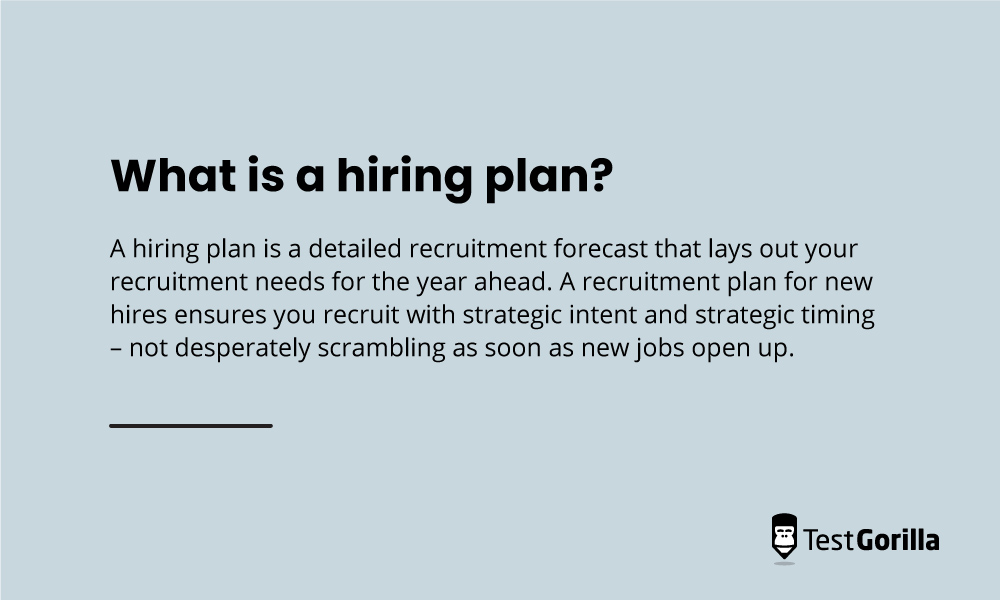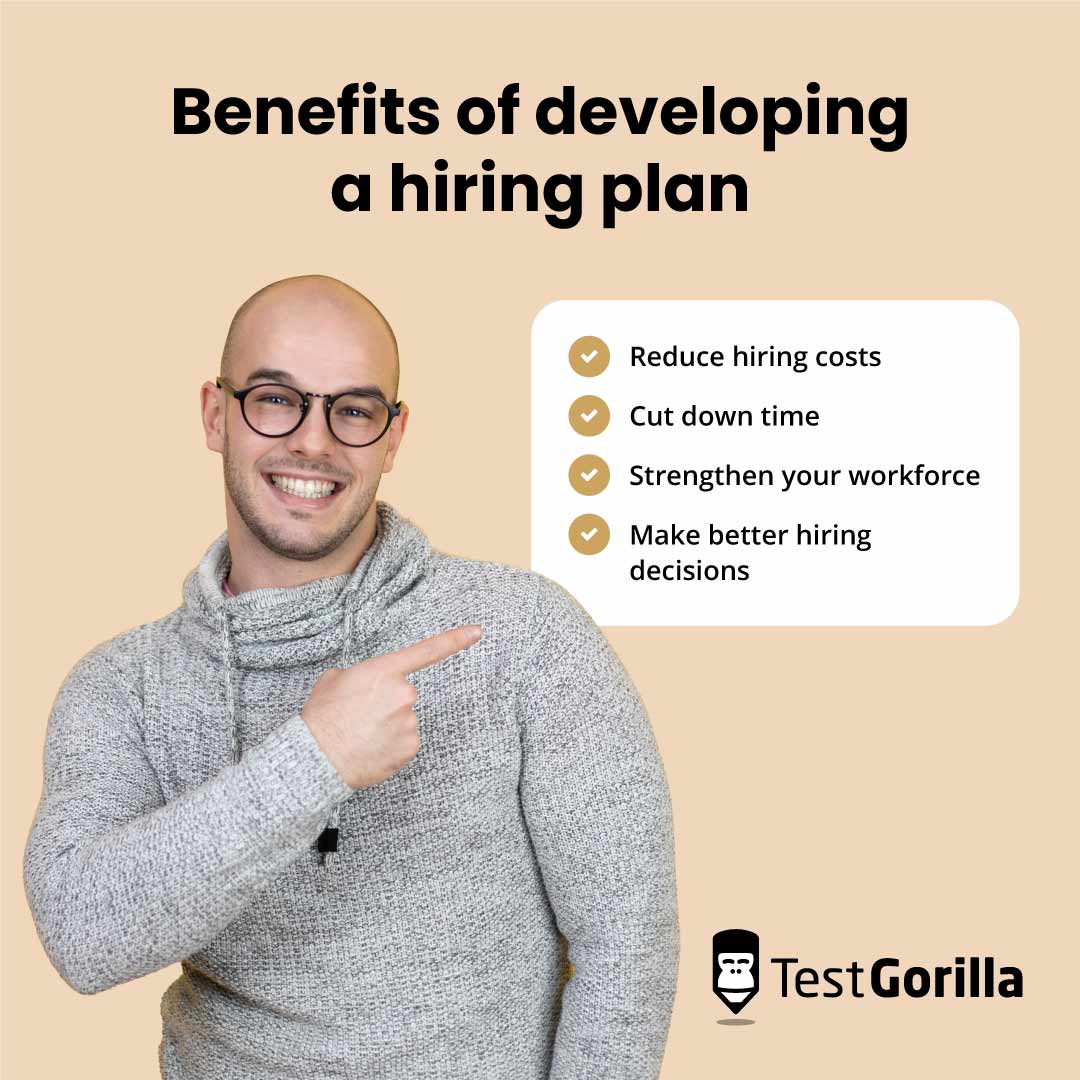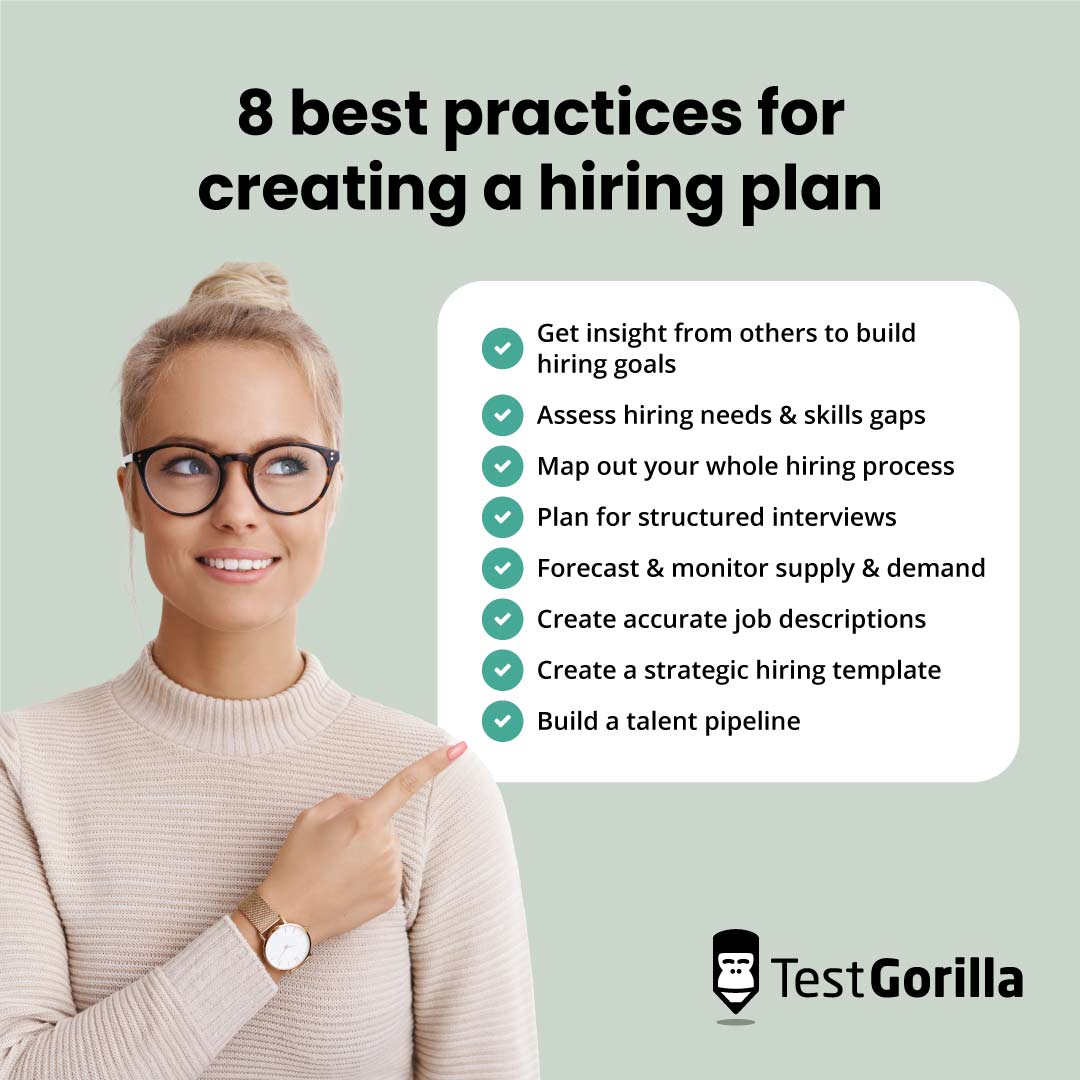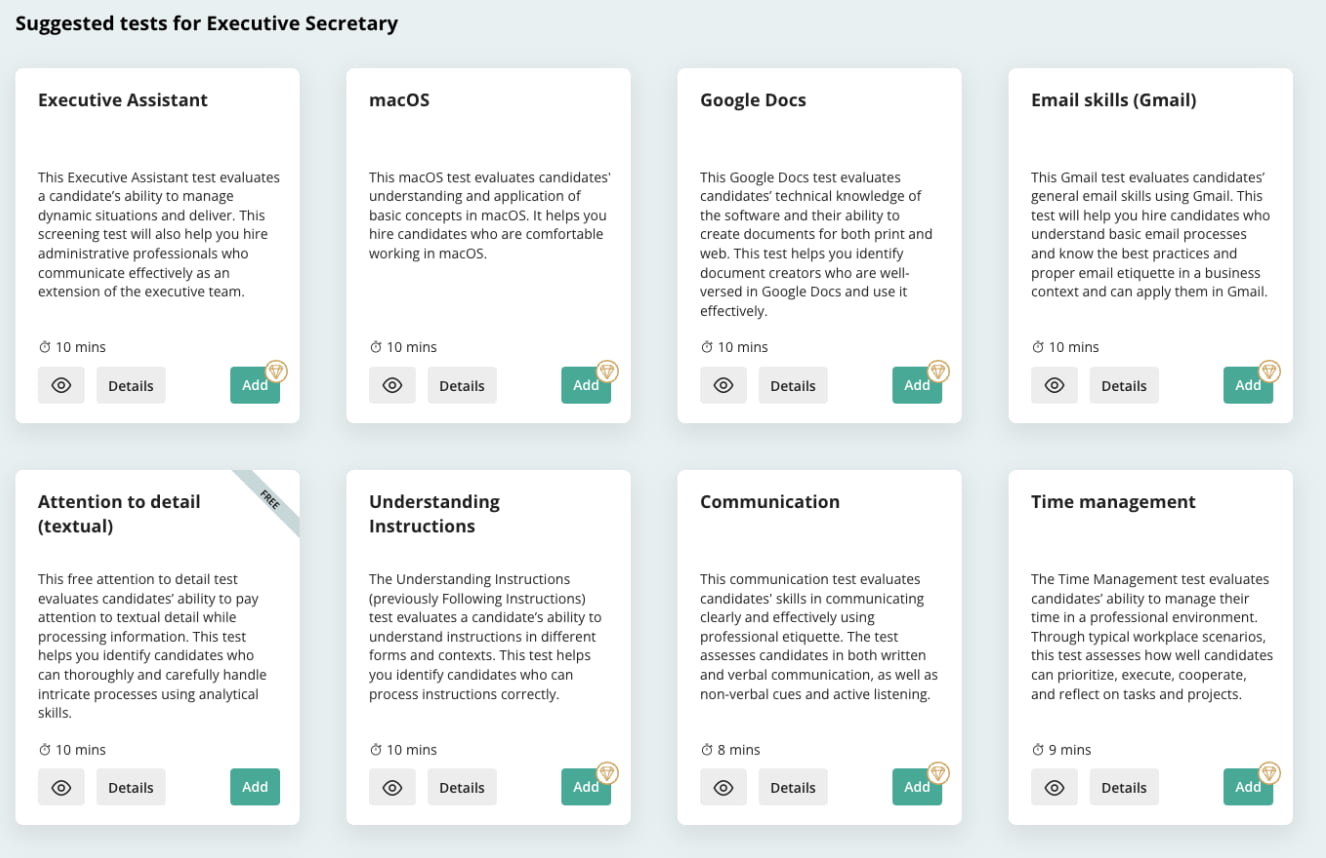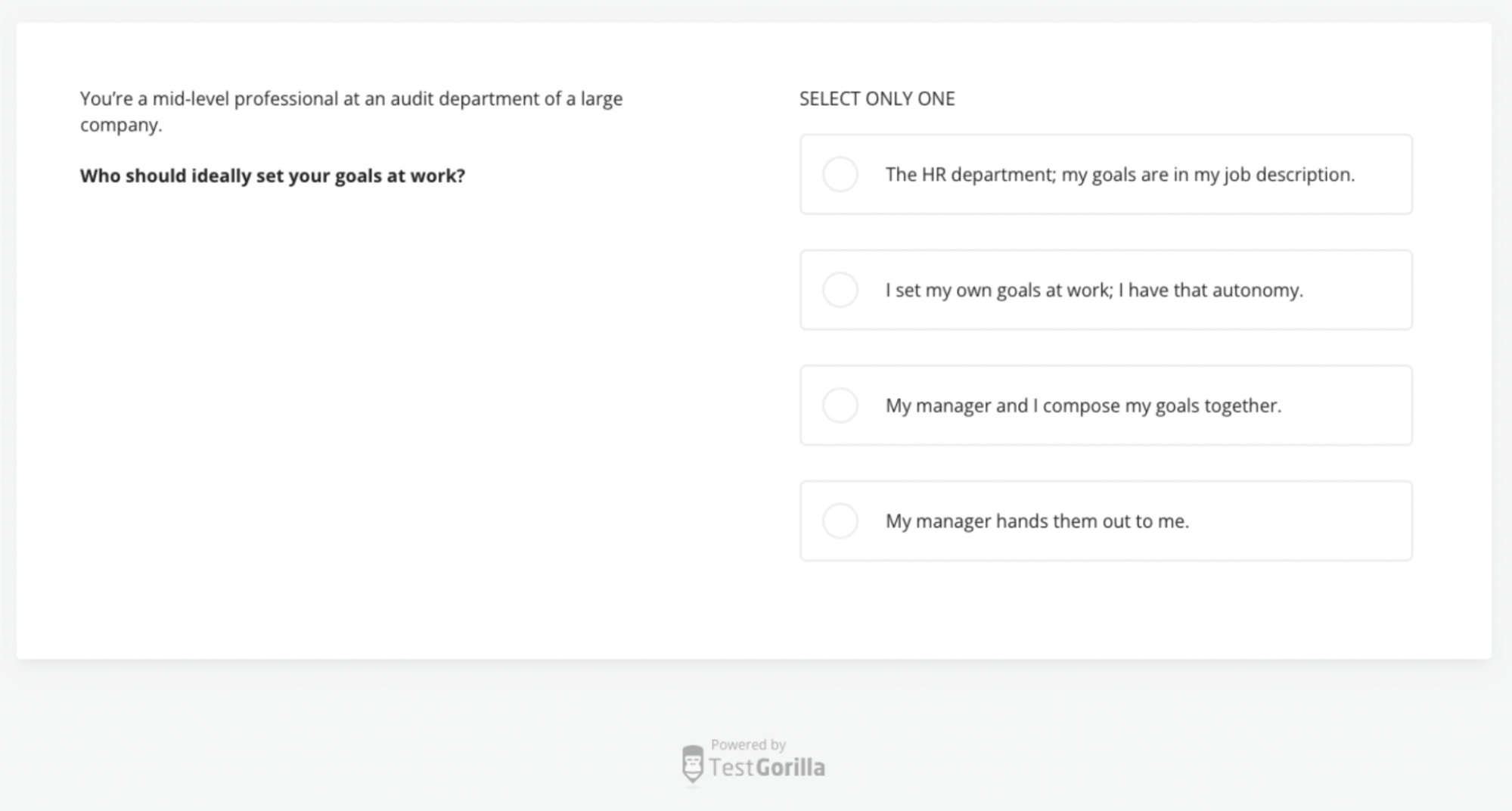Hiring plans: How to leverage this talent acquisition strategy and prepare for recruitment success
You’ve just hired a new office administrator with all the essential office administration skills. They’re a great communicator, and they know their way around Microsoft 365.
But, two months in, you realize you actually need an admin assistant who’s a whiz with artificial intelligence (AI) tools, and you don’t have time to train people.
You’re back to square one, hiring another office admin with these specific skills.
However, with a hiring plan, you always have a forecast of who you need, when, and with which skills.
Instead of hiring to fix problems, the people you recruit are relevant to your long-term goals.
A thorough hiring plan:
Cuts down recruitment costs
Prevents mis-hiring
Saves hiring time and reduces trial-and-error
In this guide, we show you what makes up the perfect plan and how to use it as a reliable talent acquisition strategy.
Table of contents
- What is a hiring plan?
- Why is a strategic hiring plan important?
- The benefits of developing a hiring plan
- 8 best practices for leveraging hiring plans to acquire top talent
- 3 examples of companies succeeding with strategic hiring plans as a talent acquisition strategy
- Create a hiring plan and prepare for future recruitment drives
What is a hiring plan?
A hiring plan is a detailed recruitment forecast that lays out your recruitment needs for the year ahead.
A recruitment plan for new hires ensures you recruit with strategic intent and strategic timing – not desperately scrambling as soon as new jobs open up.
Plans tell you:
How many people you need to hire
Which skills and departments you need to hire for
How quickly you need to fill roles
How much budget you need to allocate to hiring and recruitment marketing
Therefore, companies use plans as roadmaps instead of making ad-hoc hiring decisions.
Some businesses use different types of plans to support specific targets, such as a diversity hiring plan to back up DE&I initiatives or a startup hiring plan to focus on intensive growth.
Plans are handy for accommodating emerging talent acquisition trends, too, such as using AI in recruitment and appealing to remote employee needs.
When exploring how to create a hiring plan, you should ask yourself the following questions as a company:
What are our goals for the coming year?
What roles are necessary for us to meet these goals?
Do we have enough employees onboard to meet our goals?
What are the costs of hiring people to meet our goals?
How do we intend to find new candidates?
How many hires can we make per quarter?
Are we hiring with industry trends – such as AI technology – in mind?
During planning, all business leaders and stakeholders should weigh in so there’s a clear consensus on what’s needed, when, and what happens next. We cover why getting buy-in is so important further on in this guide.
Why is a strategic hiring plan important?
Drawing up hiring plans helps business owners and managers think about whether or not they have the internal talent to meet their future goals.
When a position opens, HR can refer to a plan and see what skills applicants need, how many people to hire, and what budget to work to.
Without a hiring plan, companies only ever hire people to resolve pressing, temporary issues.
In addition, given the average time-to-hire is a lengthy 44 days, there’s a chance these issues either become irrelevant or spiral out of control by the time new employees come on board.
Reliable plans help companies prepare more easily for unexpected industry or workforce changes without the need for these so-called quick fixes.
For example, sudden challenges hiring plans support include:
Senior employees leaving the business
Changes in roles and shifts in niche skill needs
Financially-driven layoffs
Industry shakeups – e.g., competitors leaning toward generative AI and automation to cut production time and costs
Economic recessions
Don’t forget your candidates. They appreciate structure and clarity – and plans are assets if you're focusing on improving the candidate experience.
Hiring plans show applicants you've thought carefully about what you're looking for and that you value their talents.
Moreover, narrowing down the skills needed for specific roles makes it easier to align applicants to positions based on test scores.
Doing so further reduces the risk of candidates becoming frustrated, disillusioned, or out of their depth once onboard.
The best insights on HR and recruitment, delivered to your inbox.
Biweekly updates. No spam. Unsubscribe any time.
The benefits of developing a hiring plan
Developing a hiring plan helps you:
Reduce hiring costs
Cut down time
Strengthen your workforce
Make better hiring decisions
Let’s explore these benefits in detail.
Reduce hiring costs
Without planning for the skills you need from an ideal candidate, you risk mis-hiring and thus driving up costs.
The costs of a bad hire increase due to:
Loss of productivity
Wasted training
Quiet quitting, forcing HR to recruit again and trigger severance pay
Negative impact on team morale and quality output
Potential lost customers and reputation
Hiring plans help you recruit the best possible people every time because you have a clear template HR can work with.
By reducing mis-hires, you save an average cost per hire of $17,000.
Cut down time
Time-to-hire is increasing worldwide and human resources is spending more time than ever on recruitment admin, risking top talent getting frustrated and looking elsewhere.[1]
However, with a proper recruitment strategy, recruiters make quicker, more confident, and more reasoned decisions – thus cutting time-to-hire typically spent on lengthy checks and measures.
As an example, with a list of skills required for specific roles, they could roll out test assessments and rank candidates for interviews based on their scores.
Moreover, planning saves recruiters time in finding candidates. They can fall back on the same campus recruitment or job board channels knowing they produce top talent.
Strengthen your workforce
A strong workforce can weather changes in industry, customer, and employee demand.
To illustrate, 18% of startups fail because of team, HR, or skills-based problems. They need to plan their hiring strategies to survive those difficult first few years in business.
With a plan looking at the year ahead, you can think more strategically about recruiting people to develop and rely on – and who to introduce to learning and development programs.
Building a solid core of employees with skills relevant to your goals means your HR team quickly bounces back from sudden turnover or industry challenges.
Make better hiring decisions
Hiring plans help you narrow down recruits based on their skills, not their subjective experience or other unreliable metrics.
Therefore, you have a better chance of hiring a job seeker who closely matches the exact needs of a role and who wants to stay with you.
Look at the stats: By incorporating skills testing into hiring plans, 91% of companies boosted employee retention.
What’s more, using a plan helps you consolidate roles – not just to save money but to cut back on labor time and human error.
For example, a plan might reveal you don’t need separate specialists in Python and C++ programming when one expert skilled in both languages could handle the workload.
Planning further helps you see where you could outsource work entirely, for instance, to offshore developers.
8 best practices for leveraging hiring plans to acquire top talent
Now you know why it’s important to use a business plan for hiring employees, let’s explore how to create a hiring plan using eight tried-and-tested tips.
Tips to prioritize when creating a hiring plan
Planning tip | A quick breakdown |
1. Get insight from others to build hiring goals | Communicating with managers helps you build accurate hiring goals and ensures all levels of the business buy-in and understand your hiring plan |
2. Assess hiring needs and skills gaps with talent assessments | Assessing your workforce helps you identify specific key skills and knowledge gaps you need to hire for, improving recruitment accuracy and bringing stronger talent on board |
3. Map out your whole hiring process | Creating a clear hiring process supports recruiters who refer to it as a guide, reducing guesswork – and supporting candidates looking for a well-organized hiring experience |
4. Plan for structured interviews | Structured interviewing helps tie questions to role competencies and prevent accidental bias, keeping the process inclusive and fair for all applicants |
5. Forecast and monitor supply and demand | Using hiring data analytics helps you to quickly adjust plans in the event of sudden workforce changes and shifts in demand – and to plan for longer-term goals such as turnover reduction |
6. Create more accurate job descriptions | Basing job descriptions around responsibilities helps candidates understand what skills you’re demanding, makes your employer brand more desirable, and supports recruiters in aligning the right candidates to roles |
7. Create a strategic hiring template for HR management | Creating templates from your plan helps recruiters understand their quarterly targets and keep their processes efficient |
8. Build a talent pipeline | Building talent pipelines from hiring plans gives you quick access to top talent already warmed up and almost ready to recruit |
1. Get insight from others to build hiring goals
Instead of making assumptions about what your departments and roles need, communicate with your managers and employees to build hiring goals you all agree on.
That means working with every level of the business – directors, stakeholders, CEOs, managers, and supervisors.
For instance, are they overstaffed and over budget? Could they benefit from hiring people with skills related to emerging industry trends?
Working with others early in the hiring process makes it easier for you to get final buy-in from different levels of your business once you’ve drafted your plan.
2. Assess hiring needs and skills gaps with talent assessments
You should break down the skills and responsibilities needed for each role in your plan. To start, consider using feedback from employees and leaders for accuracy.
Ask departments what their daily work involves. Narrow down their answers into specific skills and list them in your hiring strategy plan to test applicants later.
It’s worth using talent assessment software to look for skills relevant to specific roles you’re adding to your plan.
Here are some suggested skills tests for an executive secretary as suggested by our assessment builder:
From there, consider running a skills gap analysis, which shows you any skills your workforce lacks to help you meet your company goals.
Then, objectively test your existing workforce on the skills needed for each role and note any gaps. For instance, is your SEO team lacking in generative AI knowledge?
Prioritize these missing skills in your employee hiring plan and make it clear to HR and applicants that you intend to test for them.
Want to get more value from your recruitment?
Our complete blueprint will provide the tips, strategies, and insights you need to maximize your recruitment ROI.
3. Map out your whole hiring process
Cut down on hiring manager guesswork by being as clear as possible on each step of an applicant’s journey – from finding a job posting to what happens during the onboarding process.
Start by breaking down individual roles and responsibilities by, say, using the skills breakdowns mentioned above.
Then, research the cost of hiring and employing each recruit, starting with the basic salary.
From here, make it clear how you intend to spend your recruitment efforts. Are you hiring via social media recruiting campaigns, career fairs, or by listing on job boards?
What’s more, do you intend to use alternative recruitment channels such as employee referral programs? Which options do you wish to use the most for specific roles?
Then, plan your budget for each option and clarify how you intend to follow through. For example, decide which hiring team members you intend to send to career fairs to run recruitment drives.
Be clear on how you intend to qualify your candidates, too. Lay out your talent assessment test plan and the scores applicants need to hit to reach the interview stage.
You then need to decide when to begin the interview process and how you intend to structure them.
4. Plan for structured interviews
Always make structured interviews part of your hiring plan so the questions you ask tie into each role's core skills and competencies.
Structured interviews include set questions and answers you deem satisfactory for candidates to move to the next stage.
Interviewing this way gives little room for hiring bias and ensures applicants are measured on a fair basis, creating a more inclusive hiring process.
Moreover, structured interviewing and question planning help you avoid potentially illegal interview questions.
Carefully plan out the questions you intend to ask applicants in their interviews and who you need to conduct them.
Consider building upon questions asked via talent assessments – let’s use a sample question from our Time Management test:
If an applicant answers, “I set my own goals at work,” consider asking them to explain how they might schedule and handle the early stages of an imaginary project.
5. Forecast and monitor supply and demand
Always adopt an attitude of change when it comes to hiring plans. Over time, challenges alter your goals, so you need to carefully adjust the fine details of your plan so you stay on track.
You can't expect the same rigid plan you developed at the start of the process to keep satisfying these changing needs.
Adopting a data-driven recruiting approach lets you see what's happening in your departments in real time.
Doing so helps you adapt to short-term challenges, such as sudden departures or emergency project needs.
However, forecasting and monitoring hiring data help with long-term needs, too.
For example, consider leaning into talent acquisition data to monitor each department and role in your business. By monitoring employee turnover and hiring data for specific roles, you see which areas need the most planning attention.
You could find over a year that you’re constantly rehiring to fill roles in the leadership team, with people barely staying more than two to three months each.
Then, using talent acquisition analytics, map out hiring demands for each role quarter by quarter. How many people did you need to hire for Q2, for instance – and how many did you recruit? Did turnover increase?
Use these precedents to help shape predictions for the coming year, ensuring you have a core of people to rely on should there be any sudden departures.
6. Create more accurate job descriptions
Try to create job descriptions based on responsibilities, not experience – this helps to show applicants how their skills apply to specific roles.
From there, it’s easier for HR to determine whether or not said applicants are suitable for roles.
You could use data from your hiring plan to make these more accurate. For example, use information from skills gap analyses and feedback.
Then, ask for insight from your teams. What does the average day look like in a specific role, and what are the responsibilities?
Use this information alongside earlier skills analyses to better inform your descriptions.
Altogether, you benefit from high-quality candidates likely to stay with the business longer. It’s a positive benefit for employer branding because staff recommend you for your accuracy and trustworthiness.
Then, consider using accurate descriptions to help inform the questions you ask during interviews.
For instance, you could list "keyword optimization" as a key responsibility for an SEO copywriter role. In an interview, you could ask an applicant the steps they'd take to improve a blog post ranking poorly on search engines.
7. Create a strategic hiring template for HR management
Recruiters benefit from templates or spreadsheets to stick to your hiring goals – they're not just hiring in the dark.
A typical employee hiring plan template could include:
Salaries per role
Existing headcount employed per role
How many people to hire per role per period, e.g., per quarter
Future roles to hire for
Recruitment channels
Here’s a quick example of a simple hiring plan template HR can use to fulfill marketing roles in Q1:
Role | Salary | Total to hire | Hiring deadline | Recruitment channel |
Assistant Marketing Manager | $80,000 | 1 | March ‘27 | Employee referral |
Marketing Assistant | $60,000 | 5 | March ‘27 | Job board, socials, job fairs |
Graphic Designer | $50,000 | 3 | February ‘27 | Job board, socials, job fairs |
SEO Lead | $55,000 | 1 | March ‘27 | Employee referral |
Copywriter | $50,000 | 3 | February ‘27 | Job board, job fairs |
Junior Copywriter | $35,000 | 5 | March ‘27 | Campus recruitment, job fairs |
Using data you've used to build your plan, this template shows recruiters how much to spend per hire, how many people to recruit, and when they need to be on board by.
You should extend and adjust this as you wish. For example, you might include another column outlining skills for which you want to test applicants.
8. Build a talent pipeline
Talent pipelines are ideal for filling roles outlined in hiring plans because they're pools of warmed-up candidates you've already considered or connected with.
These pipelines give you fast access to suitable candidates who align with your hiring plan – provided you build your pipelines aligned with your plan's specific goals.
Therefore, build a pipeline around your hiring strategy plan by testing candidates on skills that support the roles you're hiring for, then keep their details on file. For instance, access previous candidates you've tested through TG's candidate database.
Then, arrange talent scores and refer to your pipeline when recruiting reopens in the future.
It’s a good opportunity for passive recruiting – reach out to people in your network who have yet to apply to work with you. Such people might be in your broader talent pool but not your pipeline – and a hiring plan maps out when HR should reach out to them.
Talent pipelines support internal recruitment, too. Test your workforce and arrange their scores on skills tests to prioritize them when recruiting.
Finally, use pipelines to manage boomerang employees who have left your firm and wish to return.
3 examples of companies succeeding with strategic hiring plans as a talent acquisition strategy
Even big companies make regular changes to their recruitment plans – and here are three you should take inspiration from.
Companies that keep hiring plans flexible
Company | The hiring plan in a nutshell |
Southwest Airlines | Reduced hiring overheads when client demand fell, thus cutting hiring costs and preventing overemployment |
Ford Automotive | Created a five-step plan to keep all managers and recruiters on the same page; uses applicant tracking systems and detailed feedback to grade each hiring experience |
McDonald’s | Calculates worker numbers needed for its Pakistan restaurants by breaking down task completion time and hours worked for each employee |
Southwest Airlines
Southwest Airlines reduced hiring efforts because it didn't need the extra employees.[2]
The firm intended to recruit 7,000 people over the course of 2023 but adjusted this expectation given unforeseen issues beyond its control.
This strategy primarily arose because Boeing delayed providing the airline with new aircraft it had expected to introduce into its fleet.
Hiring new pilots would have been an unnecessary expense if no new aircraft were on the schedule to arrive.
This decision helped the company continue operating within cost parameters without the risk of over-employing and overspending.
Ford Automotive
Ford Automotive works to a detailed hiring plan example based around the “CRISP” model. This is a five-step process breaking down into Clarify, Review, Interview, Select, and Prepare stages:[3]
These five stages help the company streamline its hiring process by ensuring all managers and recruiters weigh in at each decision-making point.
What’s more, the business relies heavily on data analytics to measure how its HR team and candidates perform in line with the CRISP process.
For example, the company measures its time-to-fill and hiring volumes to ascertain whether or not it's using the best recruitment channels and if HR requires additional support.
The car giant further strengthens its hiring strategies by using recruiting software such as Oracle, its applicant tracking system.
Oracle helps to grade the firm's recruiting processes through a "traffic light" system, considering net promoter scores and written feedback from recruiters and candidates.
The company then checks “green” or “good” hiring experiences as benchmarks to measure and improve “yellow” and “red” experiences.
McDonald’s
Fast food giant McDonald’s uses a two-point trend analysis system to plan recruitment, specifically in its Pakistani affiliate.
The company consults management on staff requirements based on past needs and future demand.
Then, the firm analyzes how long specific tasks take for certain employees to carry out their work and meet sales goals.
It considers employee numbers needed for each team and calculates the workable hours needed to reach sales targets.
This system ensures the company continues to meet service efficiency targets and keeps hiring to an absolute minimum.
Create a hiring plan and prepare for future recruitment drives
With a reliable hiring plan, you always have access to talent to help you reach your goals – and go beyond.
Start thinking carefully about a year from now. Who do you need in your team, and what skills should they bring?
Plan far enough ahead, and you can:
Prepare your company for sudden challenges
Give your HR team more confidence
Attract people with ideal skills for the roles you want to fill
Save time, money, and effort each time you recruit
Alongside creating a plan, we recommend learning about strategic workforce planning to ensure you always have access to the best talent to reach your goals.
Save yourself even more time and effort by learning more about AI in talent acquisition, too.
To ensure you have access to objective skills tests to fortify your hiring plan, head to the TestGorilla library for inspiration.
Sources
Chamberlain, Andrew. (August 9, 2017). “How Long Does it Take to Hire? Interview Duration in 25 Countries”. Glassdoor. Retrieved October 22, 2023. https://www.glassdoor.com/research/time-to-hire-in-25-countries
Josephs, Leslie. (April 27, 2023). “Southwest scales back 2023 hiring because of Boeing aircraft delays”. CNBC. Retrieved October 22, 2023. https://www.cnbc.com/2023/04/27/southwest-airlines-scales-back-hiring-because-of-boeing-delays.html
Thompson, Melissa. (March 2023). “Recruiting at Ford: Driving Talent Acquisition Through Operational Excellence”. Recruitment.com. Retrieved October 23, 2023. https://recruitment.com/employer-branding/ford-talent-acquisition-transformation
You've scrolled this far
Why not try TestGorilla for free, and see what happens when you put skills first.


